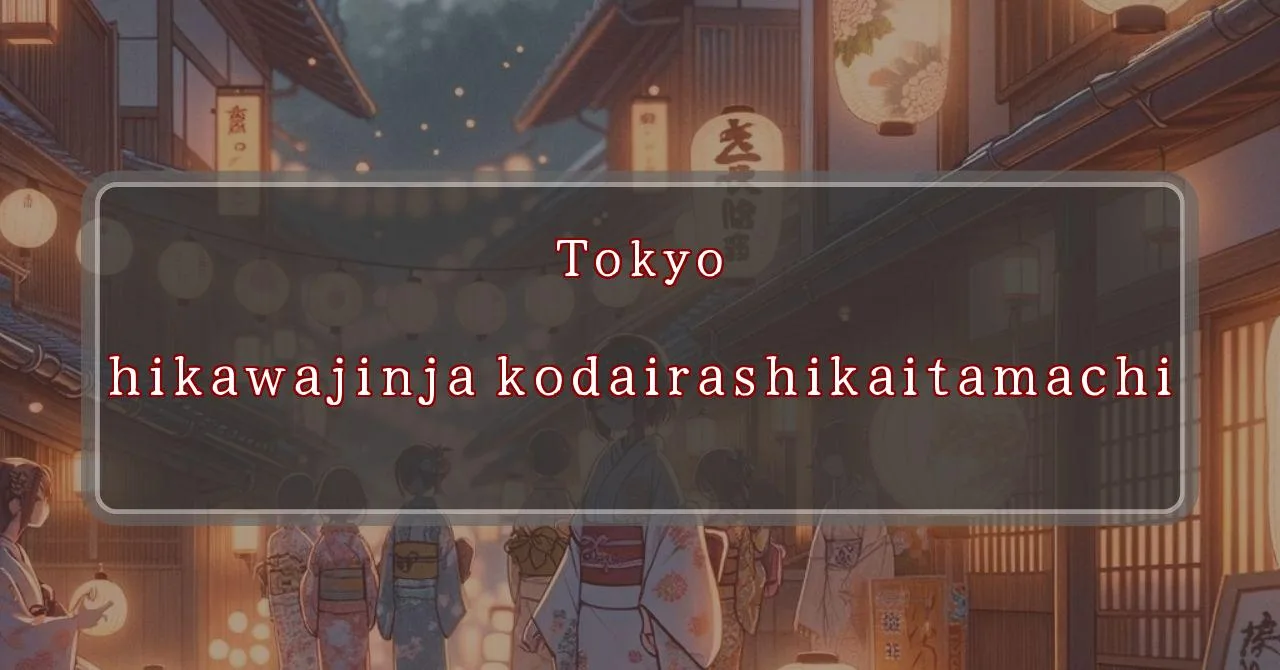Enchanting festival of lights in Asahikawa
Basic Information
Here’s an overview of the amachi Festival.
- Address: 136 Kaitamachi, Kodaira-shi, Tokyo
- Phone Number: 042-344-0638
- Access: 17-minute walk from Hitotsubashi Gakuen Station
- Festival Days: September 15th (Sunday), 2024 (Reiwa 6)
Main Events and Attractions of the Festival
The Hikawa Shrine Festival is a lively and colorful event that attracts many visitors each year. Here are some of the main highlights:
Mikoshi Procession
The highlight of the festival is the Mikoshi Procession, where a portable shrine is carried through the streets by local residents. The Mikoshi is decorated with elaborate ornaments and is believed to house the spirit of the deity enshrined at the Hikawa Shrine.
- Overview: A parade of a portable shrine carrying the deity of Hikawa Shrine
- Features: Elaborately decorated Mikoshi, lively atmosphere, and traditional music
Kagura Performance
Kagura is a traditional Japanese dance and music performance that is often performed at Shinto festivals. During the Hikawa Shrine Festival, Kagura is performed by local dancers and musicians in front of the main shrine building.
- Overview: A sacred dance and music performance dedicated to the deity of Hikawa Shrine
- Features: Graceful movements, beautiful costumes, and enchanting music
Food Stalls
No Japanese festival is complete without food stalls! At the Hikawa Shrine Festival, you can find a variety of food stalls selling traditional Japanese dishes such as yakitori, takoyaki, and okonomiyaki. There are also stalls selling souvenirs and local crafts.
- Overview: A lively market with a wide variety of food and souvenir stalls
- Features: Traditional Japanese dishes, local specialties, and unique souvenirs
Blessings and Deities
The Hikawa Shrine is dedicated to Susanoo-no-Mikoto, a powerful deity in Japanese mythology known for his bravery and strength. Susanoo-no-Mikoto is revered as the god of the sea, storms, and agriculture, and is also associated with protection against evil and misfortune.
- Susanoo-no-Mikoto: God of the sea, storms, and agriculture; protector against evil and misfortune
- Blessings: Good harvest, safe voyage, protection from natural disasters, warding off evil spirits
Origin and History
The Hikawa Shrine has a long and rich history, dating back to the Edo period. It was originally established in 1755 as a branch shrine of the Hikawa Shrine in Saitama Prefecture. Over the years, the shrine has undergone several renovations and expansions, and it is now a popular destination for worshippers and visitors alike.
- Established: 1755
- Original Shrine: Hikawa Shrine, Saitama Prefecture
- History: Renovations and expansions over the years
Tips and Notes for Visitors
If you plan to visit the Hikawa Shrine during the festival, here are a few tips to make your experience more enjoyable:
- Arrive early to avoid crowds, especially if you want to get a good spot for viewing the Mikoshi Procession.
- Wear comfortable shoes as you will be doing a lot of walking.
- Bring cash as some food stalls and souvenir shops may not accept credit cards.
- Be respectful of the shrine and its customs. For example, avoid wearing revealing clothing or making loud noises.
Parking Information
Unfortunately, the Hikawa Shrine does not have its own parking lot. However, there are several public parking lots located nearby. You can also use public transportation to get to the shrine.
- No on-site parking available
- Public parking lots nearby
- Public transportation recommended
Popular Stalls and Food Carts in Recent Years
| Type of Stall | Description |
|---|---|
| Takoyaki | A staple at Japanese festivals. Characterized by a crispy outside and a creamy inside. |
| Jaga Butter | A simple yet popular snack of hot potatoes lavishly topped with melted butter. |
| Baby Castella | Small castella cakes, sweet and fluffy treats enjoyed by children and adults alike. |
| Grilled Ayu with Salt | Fresh ayu fish grilled whole with salt, a savory taste of Japanese summer. |
| Shaapin | A unique gourmet item influenced by foreign cuisine, with a chewy skin wrapping the filling. |
| Okonomiyaki | A Japanese grilled dish where you often choose your own ingredients for a personalized flavor. |
| Cotton Candy | A fluffy, sweet snack that’s extremely popular with children. |
| Chocolate Banana | A banana coated in chocolate, a fun and visually appealing dessert. |
| Kushiyaki | Various types of ingredients skewered and grilled, an easy-to-enjoy snack. |
| Yakisoba | Fried noodles mixed with a special sauce, a fast food favorite in Japan. |



